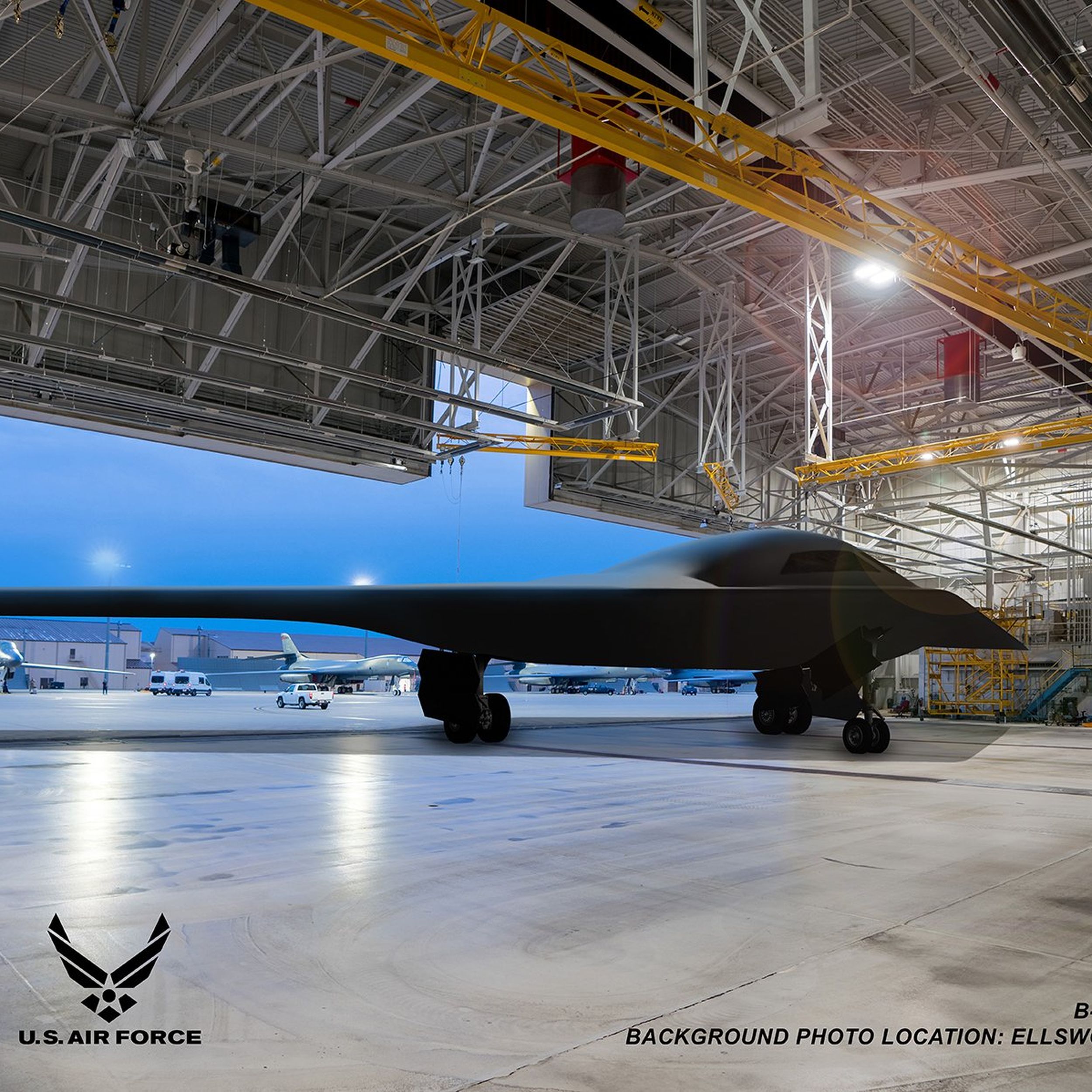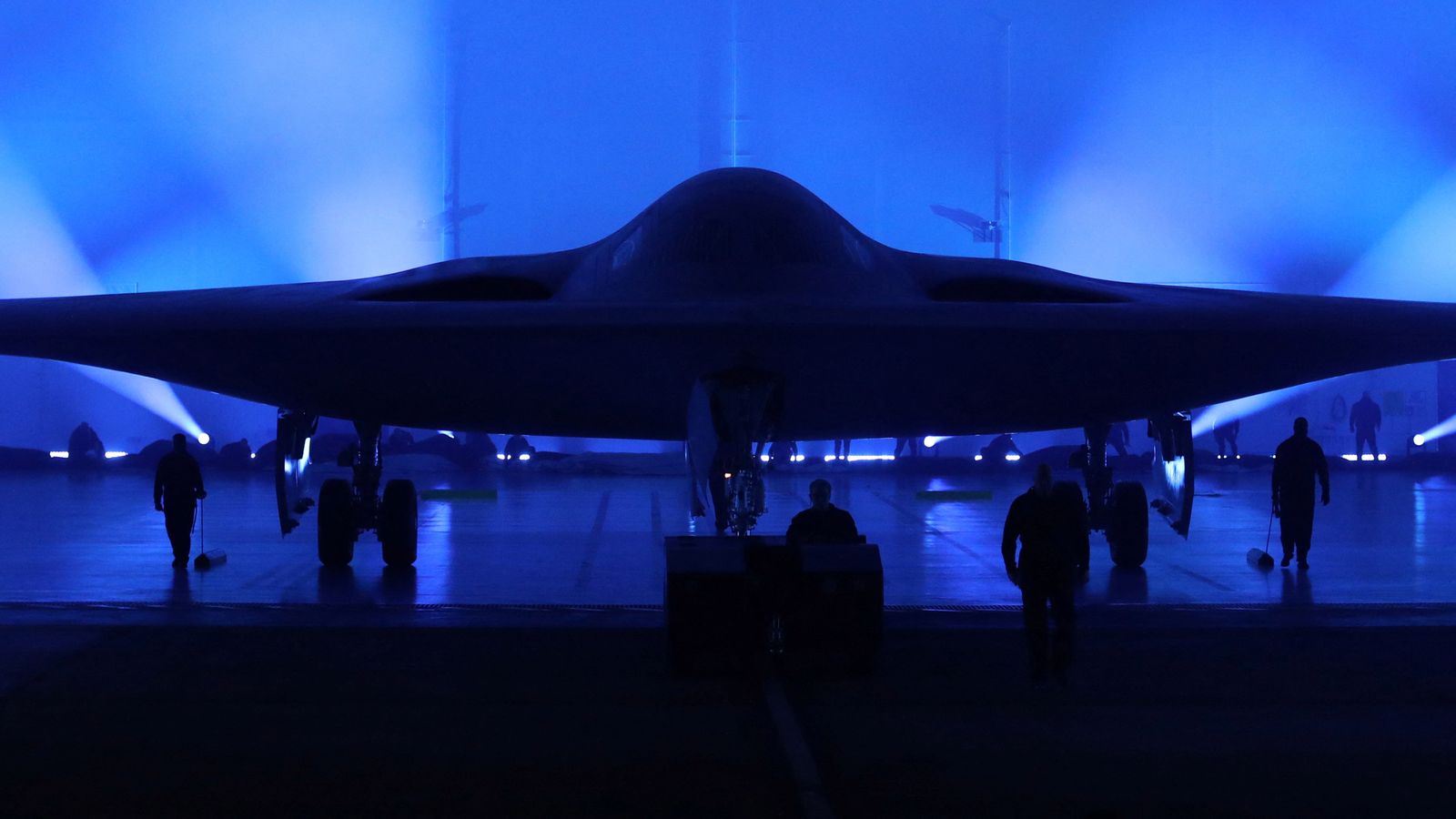New B1 Bomber - Is a supersonic variable-sweep-wing, heavy bomber used by the United States Air Force. Often referred to as "Bones" (from "B-One").
It is one of three operational strategic bombers in the US Air Force fleet by 2022, along with the B-2 Spirit and B-52 Stratofortress.
New B1 Bomber

The B-1 was first envisioned in the 1960s as a platform that would combine the Mach 2 speed of the B-58 Hustler with the range of the B-52, and to replace the bomber. was designed. After a series of lengthy studies, Rockwell International (now part of Boeing) won the design competition for what emerged as the B-1A. This version has a maximum speed of Mach 2.2 and is capable of long-range flight at Mach 0.85 at very low altitudes. A combination of the cost of the aircraft, the introduction of the AGM-86 cruise missile that flew at the same basic speed and range, and early work on the B-2 stealth bomber reduced the need for the B-1. The program was canceled in 1977 after the B-1A prototype was built.
The Most Advanced Bomber Ever: Here's What We Know About The B 21 Raider
The program was restarted in 1981, primarily as a stopgap measure due to delays in the B-2 stealth bomber program. The B-1A design was modified, reducing the maximum speed at altitude to Mach 1.25, increasing the low speed to Mach 0.96, greatly improving the electronic components, and adding fuel and more weapons to the aircraft. Optimized for carrying. Designated the B-1B, deliveries of the new type began in 1986. The aircraft entered official service with the Strategic Air Command (SAC) that same year as a nuclear bomber. By 1988, all 100 aircraft had been delivered.
With the elimination of SAC and its reassignment to Air Combat Command in 1992, the B-1B was converted to a conventional bomber role. It was first used in combat during Operation Desert Fox in 1998 and during the NATO operation in Kosovo the following year. The B-1B has supported US and NATO forces in Afghanistan and Iraq. By 2021, the Air Force has 45 B-1Bs.
The Northrop Grumman B-21 Raider will begin replacing the B-1B after 2025. All B-1s are scheduled to be retired by 2036.
In 1955, the USAF issued specifications for a new bomber combining the payload and range of the Boeing B-52 Stratofortress with the Mach 2 top speed of the Convair B-58 Hustler.
B1 Bomber Hi Res Stock Photography And Images
In December 1957, the USAF selected North American Aviation's B-70 Valkyrie for this role, a six-engine bomber capable of cruising at Mach 3 at altitude (70,000 feet or 21,000 meters).
The Valkyrie would fly at the same altitude, but at a higher speed, and the fighters were expected to take off immediately.
The XB-70 Valkyrie was chosen to replace the Hustler in 1957, but underwent a conceptual change from a high-profile aircraft to a low-altitude aircraft.

The USAF Strategic Air Command (SAC) saw these developments and began moving its bombers to low penetration before the U-2. This scheme greatly reduces the radar range by using a mask. Using terrain features such as hills and valleys, the line from the radar to the bomb can be broken, causing the radar (and human observers) to miss it.
Us Air Force Unveils New Stealth Bomber Amid Arms Race With China
In addition, radars of this era were subject to "distortion" from the return of land and other objects, which meant that there was a very small angle above the horizon that they could detect. Low-altitude bombers can stay below these angles simply by maintaining their distance from the radar site. This combination of effects made SAMs of the era ineffective against low-flying aircraft.
The result also means that low-flying aircraft are difficult to detect by high-flying interceptors, as their radar systems quickly pick out the aircraft against ground disturbances (lack of vision/shooting skills). Can not do it.
The transition from a high flight profile to a low altitude, designed for high performance, had a profound effect on the B-70. High aerodynamic drag at low altitude limited the B-70 to subsonic speeds and greatly reduced its range.
The result was a plane that was faster than the B-52, but shorter. Therefore, and the increased transfer of intercontinental ballistic missile (ICBM) forces, the B-70 bomber program was canceled by President John F. Kennedy in 1961.
B 21 Stealth Bomber Production Is Being Accelerated
Although never intended for an underpowered role, the B-52's versatility allowed it to outshine its successors as the nature of air warfare changed. The B-52's larger payload allowed it to operate at lower altitudes for longer periods of time, and its larger airframe allowed for improved radar warning and the addition of decoys to counter radar.
During the Vietnam War, the idea that all future wars would be nuclear changed to nuclear, and the "big belly" modification increased the B-52's payload to 60,000 pounds (27,000 kg).
Transforming it into a powerful tactical aircraft that can be used against ground forces with strategic objectives from high altitude.
The B-70's smaller bomb bay may make it less useful in this role.
B 2 Stealth Bomber On Mission Above Arctic Circle Outside Norway
Although effective, the B-52 was ill-suited for the low-flying role. This led to the development of several aircraft known as the Patriot, which were specifically designed for long-range low-flying flights. The first of these designs was the supersonic F-111 bomber, which used variable wings for tactical missions.
The first strategic bomber study after the B-70 was known as the Subsonic Low Altitude Bomber (SLAB), completed in 1961. He produced a design that resembled an airplane more than a bomber, with its large wings, the T. - tail, and large high bypass engines.
This was followed by the similar Extded Range Strike Aircraft (ERSA), which added variable wings, the fashion of the aviation industry. ERSA found a relatively small aircraft weighing 10,000 pounds (4,500 kg) and flying at a low altitude of 10,070 kilometers (16,210 mi) and 2,900 kilometers (4,700 mi). In August 1963, a design similar to the low-altitude manned petritor was completed, calling for a 20,000-pound (9,100 kg) bomb and a slightly shorter range of 8,230 miles (13,240 km).
All of this culminated in the Advanced Manned Precision Strike System (AMPSS) of October 1963, which led to industrial studies at Boeing, General Dynamics and North America.
How Stealth Bombers Work
In mid-1964, the USAF changed its requirements and named the project Advanced Manned Strategic Aircraft (AMSA), which differed from AMPSS primarily in that it required the same altitude capabilities as the current Mach. . 2-Class F-111.
Given the design series, Rockwell engineers joked that the new name stood for "America's most studied airplane."
The debate over the cancellation of the B-70 program led some to question the need for a new strategic bomber. The USAF has focused on deterrence as part of the nuclear triad concept, which includes bombers, ICBMs, and sea-launched ballistic missiles (SLBMs) in an integrated package that complicates all defenses. makes He said it was important to attack hard military targets and provide a safe alternative to bombs because the bombs could be moved quickly to a safe place where they could not be attacked. However, the introduction of SLBMs led to debates about mobility and survivability, and new series of ICBMs, such as the Minuteman III, had the accuracy and speed needed to strike targets. Meanwhile, ICBMs are considered a less expensive option due to their lower cost.

Defense Secretary Robert McNamara chose ICBMs over bombs for part of the Air Force's deterrent force.
B 1b, B 2, B 52, B 21: All The Bombers In The Us Air Force
McNamara continued to oppose a program to upgrade the existing B-52 fleet and add about 300 FB-111s to the smaller roles filled by B-58s.
After taking office, President Richard Nixon reestablished the AMSA program, in line with his administration's reactionary strategy that called for broader options beyond nuclear war.
Nixon's Secretary of Defense Melvin Laird reviewed the programs and decided to reduce the number of FB-111s, as the number required was insufficient, and recommended that the AMSA design study be expedited.
This was the first test of a new series of bombers, designed in 1962. The Air Force issued a request for proposals in November 1969.
In First, Air Force Flies B 1 Bomber With Externally Mounted Stealthy Cruise Missile
The original program called for two test aircraft, five flyable aircraft, and 40 engines. It was converted to one aircraft and three flight test aircraft in 1971.
The company changed its name to Rockwell International and renamed its division North American Aircraft Operations in 1973.
A fourth prototype, built to production standards, was ordered under budget in 1976. The plan called for the construction of 240 B-1As, with initial operational capability set for 1979.

Rockwell's design shared features with the General Dynamics F-111 Aardvark and the North American XB-70 Valkyrie. It used a crew escape capsule, which was released as a unit to improve crew survivability if the crew had to evacuate the aircraft at high speed. Additionally, the design included large flexible fins to provide both.
New B 21 Stealth Bomber Is Unveiled: What Did We See?
B1 lancer bomber, rc b1 bomber, air force b1 bomber, b1 bomber model, b1 bomber, revell b1 bomber, usaf b1 bomber, b1 bomber pictures, b1 bomber jacket, b1 bomber model kit, b1 bomber poster, b1 bomber photo

0 Comments